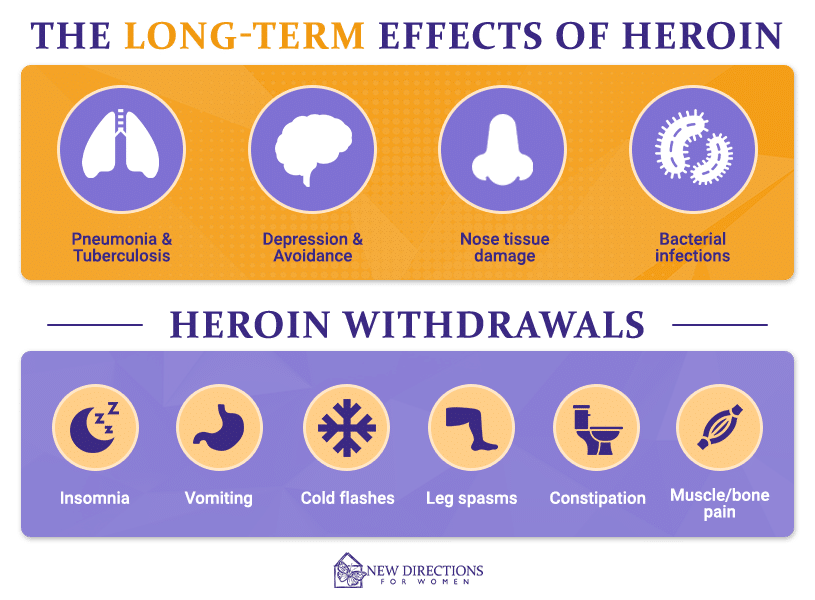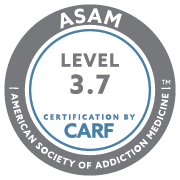After spending 11 days in detox after years of heroin abuse, the long-term effects of heroin on the body are at your doorstep. Heroin is a devastating drug that can impair the functions of the body. Due to how addictive heroin is, the long-term effects of heroin on the body can lead to financial challenges.
Common street names for heroin include:
- Dope
- Mud
- Big H
- Black Tar
- Chiva
- Hell Dust
- Horse
- Negra
- Smack
- Thunder
The rise of heroin addiction in the United States was influenced by the lack of access to prescription medication. Over 14,000 people died from a drug overdose involving heroin in the United States, a rate of more than four deaths for every 100,000 Americans. In the US, nearly a third of overdose deaths are from heroin use.
What is Heroin?
Heroin is derived from morphine, a substance that originates from the opium poppy plant. Poppy plants are grown in Mexico, South America, Southeast Asia, and Southwest Asia. Heroin is a Schedule I controlled substance, enforced by the DEA through the Controlled Substance Act. There are no accepted medical uses for heroin.
This drug and its effects do not discriminate, affecting men and women of various ages. Heroin is related to polydrug use, such as cocaine and other prescription medications. Heroin-related overdoses have become an issue in the United States.
Heroin is a rapidly acting opioid. This substance typically comes in the form of a white or brownish powder. Most street heroin is cut with another substance, such as sugar, starch, or powdered milk. Individuals may abuse heroin by injecting, smoking, or snorting it.
How Addictive Can Heroin Be?
After the first hit, heroin users could experience an initial rush of euphoria, setting them into a drowsy state. Regular heroin use can initiate a tolerance, which could develop into dependence.
Heroin is a central nervous system depressant, causing slowed responses in the body. The amount of heroin, how much is used, and how quickly it reacts in the body are what determine the development of addiction.
Heroin binds to the opioid receptors called MORs (Mu-opioid receptors). Neurotransmitters are naturally occurring chemicals that transmit messages by binding to the receptors throughout the body. These receptors help regulate mood, signal pain & pleasure, and feelings of wellbeing. MORs are activated in the reward centers of the brain.
The reward center of the brain is critical to our survival. The reward centers of the brain signal to the body to repeat pleasurable behaviors and to avoid painful experiences. The long-term effects of heroin on the body can cause a user to reinforce the behaviors, despite the negative health consequences.
How Substance Use is Affected By Gender
 The long-term effects of heroin on the body can be affected by many factors, including your sex and gender. Reports have indicated that women often use substances differently than men. Women tend to use smaller amounts of specific drugs for less time to become addicted.
The long-term effects of heroin on the body can be affected by many factors, including your sex and gender. Reports have indicated that women often use substances differently than men. Women tend to use smaller amounts of specific drugs for less time to become addicted.
Women can have more drug cravings, increasing the likelihood of relapse. For example, hormones can make women more sensitive to the effects of drugs. This can be demonstrated through the brain changes in women from drug use compared to men. Women may be more likely to die from an overdose or experience an emergency room visit.
Stress and other life events can contribute to influencing substance use. Women who are victims of domestic violence are at increased risk of substance use. In fact, divorce, loss of child custody, and death of a child/partner can directly impact substance use in women.
Substance use during pregnancy can introduce significant impacts to the health of the mother and child. Substance misuse during pregnancy can lead to miscarriages, neonatal abstinence syndrome, and premature birth. NAS can occur from opioids, caffeine, alcohol, and certain prescription sedatives. Some substances can be found in breast milk.
Substance use during pregnancy can lead to:
- Birth defects
- Low birth weight
- Small head size
- Sudden infant death syndrome
What are the Short-Term Effects of Heroin Use?
The short-term effects of heroin use could include:
- Nausea
- Dry mouth
- Drowsiness
- Flushed skin
- Respiratory depression
- Constricted pupils
Once a person injects or snorts heroin, the substance turns into morphine before binding onto the opioid receptors in the brain. After a hit, the user will begin to experience a rush of pleasurable sensations through warm flushing. When the first wave hits, the individual will begin to experience a mental and physical cloud of drowsiness for several hours.
What are the Long-Term Effects of this Drug?
The long-term effects of heroin in the body have been linked to the deterioration of white matter in the brain. This could affect a person’s ability to make decisions, regulate their behavior and respond to stress.
The withdrawal symptoms of heroin use can begin within the first 24-48 hours after use has abruptly stopped. After the peak heroin withdrawal symptoms, it should fade after a week. The long-term effects of heroin use can result in hormonal imbalances and structural changes that are difficult to reverse.
The withdrawal symptoms of heroin use:
- Insomnia
- Diarrhea
- Vomiting
- Cold flashes
- Leg spasms
- Restlessness
- Constipation
- Muscle and bone pain
Long-term heroin use can introduce a buffet of health complications. Pneumonia and tuberculosis can result from chronic heroin use. Mental health symptoms such as depression and avoidance could be present in those with a heroin use disorder. The long-term effects of heroin use on the body have indicated sexual dysfunction in men and menstrual cycle complications in women.
Individuals who repeatedly snort heroin can cause damage to the mucosal tissue in the nose. Collapses or scarred veins are examples of the long-term effects of heroin on the body. Bacterial infections of the blood vessels and heart valves, abscesses, and soft tissue damage are expected from long-term heroin use.
Long-term heroin use introduces the increased risk of developing other diseases. Sharing injection equipment or fluids can result in infections such as hepatitis B&C and HIV. In fact, these blood-borne infections can be passed on to sexual partners and children. People who inject heroin are at the highest risk of being infected with hepatitis C.
Can Heroin Use Lead to Overdose?
The effects of heroin on the body can lead to overdose. Heroin overdose can be characterized as when a person uses enough of the drug to produce a life-threatening reaction or death. When a person overdoses on heroin, their breathing becomes slowed and shallow.
The signs and symptoms of heroin overdose could include:
- Vomiting
- Scratching
- Pupils contract
- Slow heart rate
- Slurred speech
- Loss of consciousness
- Muscles appear relaxed
- Unresponsive to outside stimuli
- Loss of color of fingernails and lips
- Unfamiliar sounds when unconscious
- “Nodding off”, inconsistent wakefulness
If someone is overdosing, call 9-11 immediately. Remain calm and assess the person’s symptoms. Chances are they won’t be responsive. Stimulate them by waking them up or calling their name. Administer a hard sternum rub to the chest plate, your knuckles into their sternum or lips. Provide rescue breathing to the person.
Lay them on their side with their knees bent. Turn their face to the side in case they vomit and clear their pathway. If you have Naloxone, administer it with care and precision.

Can The Long-Term Effects of Heroin Use Be Treated?
 The long-term effects of heroin on the body can be treated through a combination of therapies, support groups, and medications. The continuum of care is designed to provide recovering individuals with the measured steps for treatment. This continuum of care employs this model through evidence-based approaches to ensure consistent results.
The long-term effects of heroin on the body can be treated through a combination of therapies, support groups, and medications. The continuum of care is designed to provide recovering individuals with the measured steps for treatment. This continuum of care employs this model through evidence-based approaches to ensure consistent results.
Addiction is a complex disease of the brain that requires physical, emotional, and sometimes spiritual healing. There are plentiful reasons why a person could end up with a substance use disorder. From genetics to the social environment, addiction treatment aims to discover the root causes of your addiction. By addressing these factors, you have a better chance of recovery.
Chronic relapse is a pressing issue in substance use. Considering how addictive heroin use can be, maintaining sobriety is a roadblock.
Detox
Detoxification is the process of removing addictive substances from the body. Drug detox is typically the first line of defense from the long-term effects of heroin on the body. The detox process can be draining, understanding how long-term heroin use can cause your body to be malnourished.
Detox can last between 7-10 days. The trained medical staff may offer medications to curb the withdrawal symptoms. An initial evaluation of your medical history will determine which treatment is best.
Residential Treatment
Residential treatment is a comprehensive approach to addiction treatment. A patient can expect to receive 24/7 care, with the guidance of medical staff. After detox, you will enter the next phase of treatment. The average length of stay at an inpatient treatment program is 30 days, however, 60-90+ days are common.
Despite each facility providing different amenities, inpatient treatment programs will offer psychotherapy such as individual and group therapy. Medications can be provided for those with pre-existing conditions. Inpatient treatment programs are best suited for those with severe to moderate cases of addiction.
Outpatient Treatment
Outpatient treatment programs offer patients the opportunity to go back to their daily responsibilities and to receive treatment. The average length a patient remains in outpatient treatment is 30 days. Outpatient treatment provides individual and group therapy as well, with some facilities allowing amenities such as holistic or massage therapy. Outpatient treatment programs entail sessions that run from 4-6 hours for 5 days a week. This type of rehab program can be a discreet, flexible, and affordable option for those in recovery.
Medication-Assisted Treatment
Medication-assisted treatment is a valuable resource for those struggling with the long-term effect of heroin on the body. This type of treatment can be administered through a private facility or hospital. Medication-assisted treatment is conducted through the care of trained medical professionals that monitor your condition.
The physical side effects of long-term substance misuse can present complicated health conditions from anxiety, depression, nausea, and even coma (in extreme cases). Studies have proven that medication-assisted treatment for substance use disorders can improve the quality of care for patients. With medications, patients can be relieved of the health consequences and focus on the behavioral changes necessary for growth.
Sober Living
Sober living homes are a gateway for those who need a support system and a consistent living environment. These environments typically require you to have a stable job, in exchange to receive treatment. Sober living homes are great for those who have transitioned from an inpatient residence. Adapting to life after the first treatment of addiction can be challenging. Investing in the community through support groups can provide insights into how to cope.
What are Medications Used for Heroin Use?
Medications for substance use can be a coat of armor against the long-term effects of heroin on the body. Opioid withdrawals can be physically and mentally exhausting on a recovering individual. The FDA approved lofexidine, a non-opioid medicine designed to reduce opioid withdrawal symptoms.
In fact, the medications used to treat opioid use disorders work through the same opioid receptors. The medications are considered safer and less likely to cause harmful effects. Medications to treat the long-term effects of heroin on the body are not a single solution; comprehensive care and determination are necessary for lifelong recovery.
Methadone
Methadone is a slow-acting opioid agonist. Since the 1960s, methadone has been used to treat heroin use disorders. This medication is taken orally, reaching the brain slowly to reduce the “high”. Methadone is great for patients who do not respond well to other medications. However, methadone is only approved for certain outpatient treatment programs, where it can be released on a daily basis.
Buprenorphine
Approved by the FDA in 2002, buprenorphine is a partial opioid agonist. Buprenorphine relieves drug cravings without producing “high” or other side effects. Suboxone, which contains Naloxone, is the formulation of buprenorphine that’s taken orally or sublingually. Suboxone prevents attempts to get high by injecting the medication.
Naltrexone
Naltrexone is an opioid agonist, which blocks the action of opioids. It is not addictive or sedating, which does not result in physical dependence. On the other hand, patients often have trouble complying with treatment. Vivitrol, a long-acting injectable version of Naltrexone was FDA approved in 2010. In fact, Vivitrol is administered once a month and may improve daily use by eliminating the need for daily dosing.
New Directions Invites You to Heal
The long-term effects of heroin on the body can leave you in a tailspin. Addiction treatment can help you get back on track with healthy living. Your hard work and determination will be rewarded by the restored version after recovery. New Directions for Women aims to usher you through this journey, with detailed care and consistent therapies. If you or a loved one are warring with a substance use disorder, please contact us today.
References:
https://www.drugabuse.gov/publications/drugfacts/substance-use-in-women
https://www.drugabuse.gov/publications/research-reports/heroin/what-are-long-term-effects-heroin-use
https://www.drugabuse.gov/publications/research-reports/substance-use-in-women/summary
https://www.drugabuse.gov/publications/drugfacts/heroin
https://harmreduction.org/issues/overdose-prevention/overview/overdose-basics/recognizing-opioid-overdose/
https://www.drugabuse.gov/publications/research-reports/heroin/what-are-treatments-heroin-use-disorder












